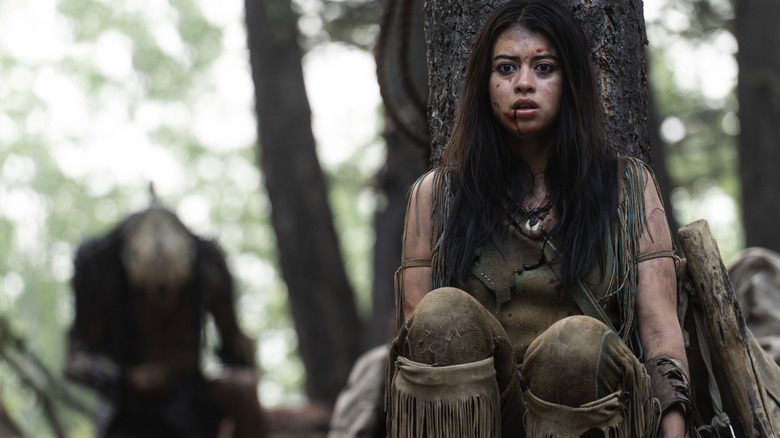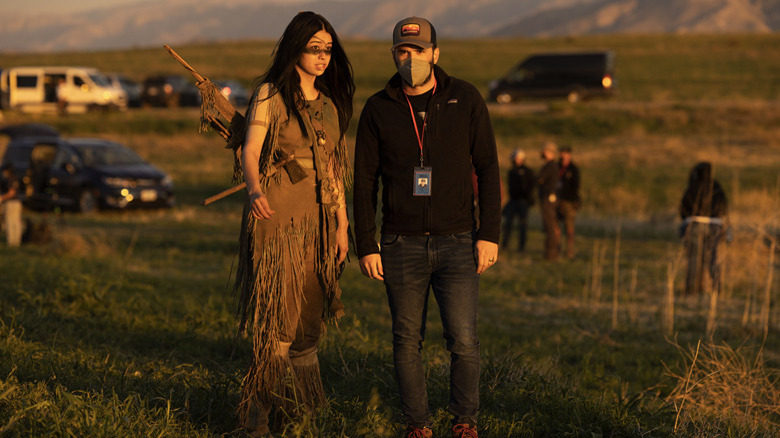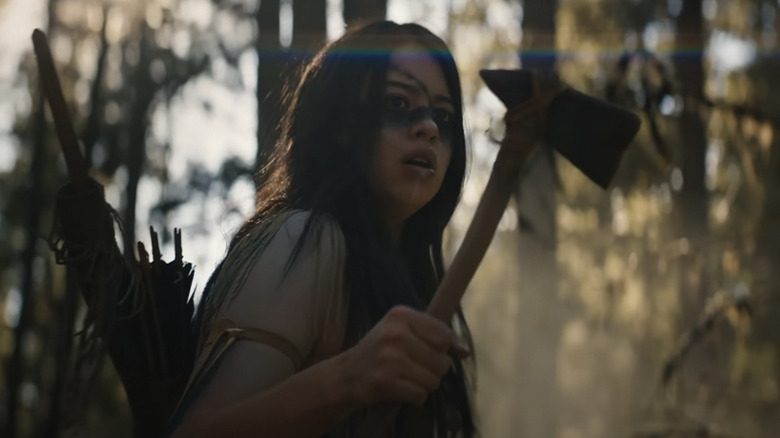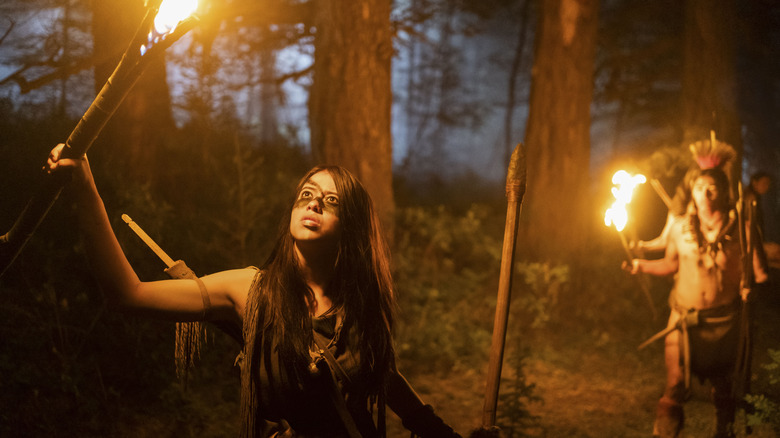Prey Director Dan Trachtenberg On An Action Scene That Was Almost Included [Interview]
I'm a big fan of director Dan Trachtenberg. His feature film debut, "10 Cloverfield Lane," was among my favorite movies of 2016, so I've kept an eye out any time he's been linked to a project and have been hotly anticipating his next movie. I was intrigued when word came out that he would direct a mysterious movie called "Skulls," and then became a little heartbroken to learn that a surprise had been ruined in a trade report: "Skulls" was originally meant to be a secret "Predator" movie, in which none of the marketing would have given away that an alien was involved in the story. Trachtenberg, fully aware of how the pop culture landscape works, was engineering a surprise reveal that could have resulted in a burst of excitement for genre fans akin to what audiences felt watching the ending of M. Night Shyamalan's "Split."
We'll never know how cool it might have been to settle in to watch a thriller about a young Comanche warrior and slowly realize that she's facing off against a legendary sci-fi creature. But thankfully, "Prey" is entertaining enough without relying on a secret twist. It's a stripped-down, efficient piece of storytelling with a unique setting, a compelling protagonist at its center, and some killer action. With those elements and a filmmaker who knows how to weave them together, "Prey" manages to feel like it subverts the franchise's tropes while simultaneously playing into them.
I caught up with Trachtenberg and producer Jhane Myers to chat about one particular easter egg, a couple of the film's long continuous shots (aka "oners"), and the aspects of this story the director was especially excited to include.
'We pre-vized and almost had a fight where they were both up in trees in a treetop chase'
Dan, once you and [writer] Patrick [Aison] settled on a basic framework of this story, what was the one thing that you were insistent upon being in this movie? Was there a specific moment or a shot or "the Predator has to do this" move that you were especially excited about including?
Trachtenberg: Hmm. Okay. I'll think of a couple things, even though you just said one thing. We definitely needed the "Road Warrior" thing with a girl and her dog, we really wanted in the movie. I was, for whatever reason, really obsessed with having the fights be more vertical and seeing the Predator leaping through trees. By the way, I'm just now remembering there was an original draft for this for a long time — I mean, not just the draft, we pre-vized and almost had a fight where they were both up in trees in a treetop chase, just because that was hinted at in the physicality in the original "Predator" movie and never fully capitalized on. I really wanted to see this Predator creature be so much more alien and feral and ferocious, and move in a way that is distinctly not human and not like a man in a suit could move. So having all that stuff was a big part of the equation for me, for sure.
Jhane, last time we spoke, you told me that you were a big Predator fan. So I'm curious to know from you about the decision to include the pistol from "Predator 2" in this movie.
Myers: Well, I would love to tell you that was my decision, but it wasn't. (laughs). But the fact that it was in there was just amazing, because before, you just saw the pistol and your imagination, right? I was young in the '80s, and I remember watching that film and I really — I mean, I liked the Predator of that time, but I didn't like the look and all this other stuff. But anyway, the cool thing was at the end when the pistol was handed to [Danny Glover's character]. And I did think back then, "I wonder who that is?" And the fact that we have [the character] Raphael [Adolini] in this film is amazing, because then it'll just probably blow the minds of all the "Predator" fans, because they get a visual of who he is.
'I was really rebelling against that'
Dan, there are two oners that I wanted to talk to you about, and they're very different. The first is early on, following Naru as she walks through the village. I thought the camera placement was interesting there because it starts out behind her, but then she turns toward it, and the majority of that shot is with her facing the camera as the camera moves backward. Those types of establishing shots are frequently done from behind the main character. Can you talk a little about that first?
Trachtenberg: Sure. Yeah. That was covered, and the natural instinct for me — for, I think, any filmmaker — is like, "Oh, it should be a oner so we can see the whole camp in one moment..." So I was really rebelling against that and we did cover it that way, but we did a lot of other bits because I really wanted to show what life was like and focus on these interesting little moments. And it just didn't feel right. Then I was like, "Oh God, I got to do the thing that everyone else — anyone would think to do this, and we're doing it." I wanted to have my cake and eat it, too. It always, for me, was inspired by watching "The Wrestler," where so much of that movie is behind Mickey Rourke's back. So now we have both: We are behind her, but then we get to be in front of her and experience what she's going through while also seeing the world around her.
I will say there's one little nugget of that shot that I love that I'm sure most people will not notice is at the very, very beginning of it, there's another dog in the frame that was scripted as like, "It runs up to Sarii and tries to play with Sarii, and Sarii's not having it," or whatever. And the dog just froze when we started rolling. (laughs) And it's just there, just panting in the shot. But I love the life that brings, that there's all these other little animals.
'It felt like that immersion would be worth it if we could pull it off'
And then the second oner is the big action shot in the trapper camp, later on. And it sounds like just a second ago, you were sort of hesitant about using a oner, and I'm wondering if you could talk about your mentality going into that big action scene later on.
Trachtenberg: Boy, did I wrestle with it. Same thing. For whatever reason, oners have become this en vogue thing in action filmmaking these days. So I really was hesitant, because for me, growing up as a fan of Hong Kong action movies and really treasuring great, inventive choreography and cleanliness of choreography, and the understanding of geography in an action scene, it's hard to marry that with a oner that doesn't feel like it's showboaty or that does not feel like you're still immersed in what the natural filmmaking of the movie has been up until that point. So I really wrestled with it. But I was obviously interested in making it feel like she's doing this thing all in one breath, you know? It felt like that immersion would be worth it if we could pull it off.
I think what happened is we found a way to cover it that, I hope, doesn't feel showboaty, where the cameraman is only just barely capturing what's there, without feeling too aggressively handheld in a "Bourne" way, where it's not feeling overly messy. So we're still seeing all the inventive, clever bits of choreography, but still feeling like it's got the ferocity and velocity that she is using to take down all of those fur trappers. And that, at the end, you're like, "Oh my God, I wasn't breathing that whole time!" So that was the intention.
"Prey" is now streaming on Hulu.



